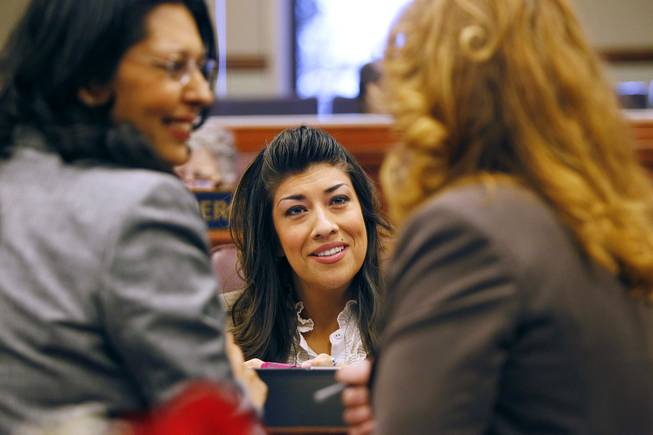
Sam Morris / Las Vegas Sun
From left, Assemblywomen Olivia Diaz, Lucy Flores and Assembly Speaker Marilyn Fitzpatrick talk before the start of an Assembly session during the third day of the 2013 legislative session Wednesday, Feb. 6, 2013 in Carson City.
Friday, Feb. 20, 2015 | 2 a.m.
A bill that would make it easier for some immigrants to teach in Nevada's classrooms is gaining momentum in the Legislature because it would help alleviate the state's crippling teacher shortage.
Assembly Bill 27, which has broad support and cleared its first legislative hurdle on Wednesday, has special significance for the state’s immigrant community. The bill’s success would be a small victory for advocates who are reeling from a blow dealt by a court decision this week that temporarily halted a federal program that would have spared tens of thousands from deportation in Nevada.
Here’s what you should know about AB27:
It would benefit people who have work permits through the Deferred Action for Childhood Arrivals program, which grants deportation relief to undocumented immigrants who entered the United States as children.
Existing law lets the state superintendent give teaching licenses to those who aren’t citizens but have work permits only if there’s a teacher shortage for the subject that person can teach. Otherwise, only U.S. citizens and legal residents can apply.
The bill would loosen that requirement and let immigrants get teaching licenses if a district has a teacher shortage of any kind.
“What this boils down to is an expansion of a program that already exists, to bring more qualified people into the workforce,” said former Assemblywoman Lucy Flores, a vocal immigration advocate. “We have to get creative and bring in ready and willing people into the teaching profession.”
In addition to alleviating Nevada’s shortage of 2,500 teachers, supporters say it would help diversify Nevada’s teacher pool and bring it more in line with the racial makeup of the state’s students.
In the Clark County School District — which educates most Nevada children — 70 percent of students are nonwhite while 76 percent of its licensed educators are white, according to a 2012 study by Education Week. Nevada’s so-called “teacher diversity gap” was ranked the second largest in the nation, surpassed only by California.
“There is a growing need to diversify our workforce,” said Assemblywoman Olivia Diaz, who teaches fifth grade at CC Ronnow Elementary. “This way we’ll have a more diverse pool and potentially even bilingual teachers who can communicate better with students and parents.”
The bill, spearheaded by the Nevada Department of Education, has widespread support and faces minimal opposition.
AB27 got approval on Wednesday from the Assembly Education Committee, and now it’s headed to the Assembly floor for a vote. The bill is being lobbied by agencies that include CCSD and the Nevada State Education Association, the state’s teacher union.
“Regardless of whether you’re in Clark County or Washoe County, there’s a teacher shortage,” said NSEA President Ruben Nurillo. “Any teacher who comes in — whether from the U.S. or abroad — should have the support to help make them successful.”
Most who have testified before the Assembly Education Committee say they’re in favor of the bill. But at an earlier meeting before the committee last week, John Wagner of the Independent American Party said he objected to the measure because it encouraged illegal immigration.
“Why don’t people come out of retirement temporarily?” Wagner said. “There are other ways of getting teachers.”

Join the Discussion:
Check this out for a full explanation of our conversion to the LiveFyre commenting system and instructions on how to sign up for an account.
Full comments policy